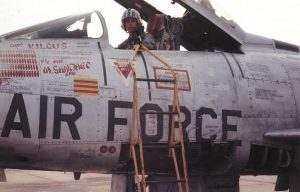An excerpt from Dario Leone’s The Aviation Geek Club website…
 Capt Don Kilgus pursued a MiG-17 in a steep dive from 20,000 ft down to 7000 ft, firing several bursts from his 20 mm cannons and observing hits on the fighter’s right stabilator.
Capt Don Kilgus pursued a MiG-17 in a steep dive from 20,000 ft down to 7000 ft, firing several bursts from his 20 mm cannons and observing hits on the fighter’s right stabilator.
On April 4, 1965, during the second Rolling Thunder attack on the crucial Than Hoa Bridge, 75 miles from Hanoi, F-100Ds of the 416th Tactical Fighter Squadron (TFS) were tasked with performing combat air patrols as cover for any rescue attempt for downed aircrew (ResCAP). Their job was to defeat any MiG-17s that tried to intercept a 48-strong strike force of F-105D Thunderchiefs.
As explained by Peter E Davies and David W Menard in their book F-100 Super Sabre Units of the Vietnam War, it was their experience that day which resulted in the fighter’s only (probable) MiG kill of the war and, paradoxically, its withdrawal from the MiGCAP role over North Vietnam. Having engaged US Navy fighters with some success on Apr. 3, the VPAF’s 921st FR was emboldened into engaging the F-105 strike package.
The RESCAP F-100D flight (`Green’ flight), carrying 2.75-in rocket pods, set up an offshore orbit, ready to move in and cover for the SAR forces if required. Although the MiG pilots seldom ventured across the coast because of US Navy Barrier CAP (BARCAP) fighter patrols, their radar controllers vectored two of them behind ‘Green’ flight from a head-on approach. The 416th TFS jets turned to meet them, and Capt Don Kilgus (`Green 2′) pursued a MiG-17 in a steep dive from 20,000 ft down to 7000 ft, firing several bursts from his 20 mm cannons and observing hits on the fighter’s right stabilator. He and other flight members saw pieces fly off the MiG, but at the last moment Kilgus had to pull out of his dive, whereupon he lost sight of the target in the hazy conditions above the Gulf of Tonkin.
he MiGCAP (Purple’) flight, led by 416th TFS CO Lt Col Emmett Hays, established their BARCAP circuit 60 miles further north, blocking the presumed ingress route of MiGs for Noi Bai. Capt Keith Connolly (`Purple 2′) detected four MiG-17s approaching the 354th TFS’s ‘Zinc’ flight of F-105Ds from low altitude through cloud and haze. ‘Zinc’ flight had been caught out by time-over-target complications due to poor weather and in-flight refuelling delays. Instructed to orbit south of the target and await their turn to bomb, they were dangerously remote from the MiGCAP’s protection. Capt ‘Iran Hanh’s MiG-17 flight was vectored onto them as they cruised at 375 knots with heavy bomb-loads, incapable of evasive maneuvering.
Although Connolly called a warning to ‘Zinc’ leader as his flight closed the distance on the MiGs at maximum speed, it was lost in the general radio chatter, and Tran Hanh was able to approach to around 1200 ft before opening fire at Capt James Magnusson’s Thunderchief (59-1764) with his three cannons. The blazing F-105D fell away and its pilot died when the aircraft crashed south of Than Hoa. Tran Hanh’s flight then split into two elements, and the second, led by Le Minh Huan, shot down the F-105D (59-1754) flown by ‘Zinc’ lead, Maj Frank Bennett, who drowned when his fighter crashed into the sea.
Responding to the crisis, Lt Col Hays and Capt Connolly of ‘Purple’ flight engaged their afterburners and closed to within Sidewinder missile range of the VPAF flight. Connolly fired an AIM-9B, which narrowly missed Le Minh Huan’s right wing, and a second Sidewinder was also fired unsuccessfully. Connolly followed up with 20mm fire, but the MiG-17s maneuvered to evade his bullets and dived for home.
Although Kilgus was confident that ‘his’ MiG could not have survived, he was only awarded a ‘probable’ kill because no one had seen a pilot eject or an aircraft crash. Requests to reconsider his claim were denied by the USAF, partly because President Lyndon Johnson had said that he did not want any MiGs to be shot down in case aerial engagements of this kind provoked North Vietnam’s Russian and Chinese sponsors. However, the VPAF flight leader, Tran Hanh, later admitted that three of his MiG-17s and three pilots (Snr Lts Le Minh Huan and Pham Giay and Lt Tran Nguyen Nam) had been lost that day, all to USAF fighters, although North Vietnamese AAA may also have been partly responsible.
No USAF claims were made apart from Kilgus’. In any case, Capt Kilgus painted a MiG kill marking beneath the windscreen of F-100D 55-2894, Kay Lynne, and another on the F-105G Wild Weasel that he flew later in the war, although he was ordered to remove the latter by the 44th TFS CO.
F-100 Super Sabre Units of the Vietnam War is published by Osprey Publishing and is available to order here.
c.2020 Dario Leone
Dario Leone is an aviation, defense, and military writer. He is the Founder and Editor of “The Aviation Geek Club” one of the world’s most-read military aviation blogs. His writing has appeared in The National Interest and other news media. He has reported from Europe and flown Super Puma and Cougar helicopters with the Swiss Air Force.
